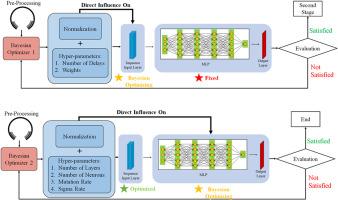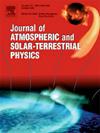Bayesian-optimised hybrid machine learning model for coastal wind gust prediction in a marine-influenced atmospheric boundary layer
IF 1.9
4区 地球科学
Q3 GEOCHEMISTRY & GEOPHYSICS
Journal of Atmospheric and Solar-Terrestrial Physics
Pub Date : 2025-09-14
DOI:10.1016/j.jastp.2025.106629
引用次数: 0
Abstract
Accurate prediction of wind gusts is crucial for applications in aviation, coastal and marine operations, and atmospheric dynamics research. This study presents a novel model combining a Sequencing Block and a Layer Perceptron (MLP) optimised using Bayesian Optimisation (B-MLP) to enhance the precision of coastal atmospheric wind gust forecasts. The model is validated using a 13-year dataset (January 2010 to March 2023) from Muscat International Airport, a coastal site influenced by Gulf of Oman sea–land breeze interactions. The Sequencing Block is designed and developed to capture the optimal arrangement of dataset segmentation using atmospheric and boundary layer parameters, thereby enhancing the model's predictive accuracy. The B-MLP model's efficacy is compared against traditional methods, including Decision Tree (DT) and Support Vector Regression (SVR), demonstrating a substantial enhancement in forecast quality. The B-MLP model achieves a correlation coefficient of 0.817 between actual and forecasted wind gusts, outperforming DT and SVR by notable margins in both accuracy and error reduction. The newly proposed model is validated using a 13-year dataset (January 2010 to March 2023) from Muscat International Airport, a coastal site influenced by Gulf of Oman sea–land breeze interactions, to prove its robustness and applicability on a 1-day ahead prediction horizon. The proposed B-MLP model improves forecast accuracy and offers a scalable solution for atmospheric boundary layer studies, marine safety applications, and real-time meteorological data analysis.

海洋影响大气边界层中海岸阵风预测的贝叶斯优化混合机器学习模型
准确预测阵风对于航空、沿海和海洋作业以及大气动力学研究的应用至关重要。为了提高沿海大气阵风预报的精度,提出了一种结合序列块和层感知器(MLP)的新模型,该模型采用贝叶斯优化(B-MLP)进行优化。该模型使用马斯喀特国际机场的13年数据集(2010年1月至2023年3月)进行了验证,马斯喀特国际机场是受阿曼湾海陆风相互作用影响的沿海站点。测序块的设计和开发是为了捕捉使用大气和边界层参数的数据集分割的最佳安排,从而提高模型的预测精度。将B-MLP模型的有效性与传统方法(包括决策树(DT)和支持向量回归(SVR))进行了比较,结果表明B-MLP模型在预测质量方面有了实质性的提高。B-MLP模型在实际阵风和预测阵风之间的相关系数为0.817,在精度和误差减少方面都明显优于DT和SVR。新提出的模型使用马斯喀特国际机场的13年数据集(2010年1月至2023年3月)进行验证,马斯喀特国际机场是一个受阿曼湾海陆风相互作用影响的沿海站点,以证明其在提前1天预测范围内的稳健性和适用性。提出的B-MLP模式提高了预报精度,并为大气边界层研究、海洋安全应用和实时气象数据分析提供了可扩展的解决方案。
本文章由计算机程序翻译,如有差异,请以英文原文为准。
求助全文
约1分钟内获得全文
求助全文
来源期刊

Journal of Atmospheric and Solar-Terrestrial Physics
地学-地球化学与地球物理
CiteScore
4.10
自引率
5.30%
发文量
95
审稿时长
6 months
期刊介绍:
The Journal of Atmospheric and Solar-Terrestrial Physics (JASTP) is an international journal concerned with the inter-disciplinary science of the Earth''s atmospheric and space environment, especially the highly varied and highly variable physical phenomena that occur in this natural laboratory and the processes that couple them.
The journal covers the physical processes operating in the troposphere, stratosphere, mesosphere, thermosphere, ionosphere, magnetosphere, the Sun, interplanetary medium, and heliosphere. Phenomena occurring in other "spheres", solar influences on climate, and supporting laboratory measurements are also considered. The journal deals especially with the coupling between the different regions.
Solar flares, coronal mass ejections, and other energetic events on the Sun create interesting and important perturbations in the near-Earth space environment. The physics of such "space weather" is central to the Journal of Atmospheric and Solar-Terrestrial Physics and the journal welcomes papers that lead in the direction of a predictive understanding of the coupled system. Regarding the upper atmosphere, the subjects of aeronomy, geomagnetism and geoelectricity, auroral phenomena, radio wave propagation, and plasma instabilities, are examples within the broad field of solar-terrestrial physics which emphasise the energy exchange between the solar wind, the magnetospheric and ionospheric plasmas, and the neutral gas. In the lower atmosphere, topics covered range from mesoscale to global scale dynamics, to atmospheric electricity, lightning and its effects, and to anthropogenic changes.
 求助内容:
求助内容: 应助结果提醒方式:
应助结果提醒方式:


